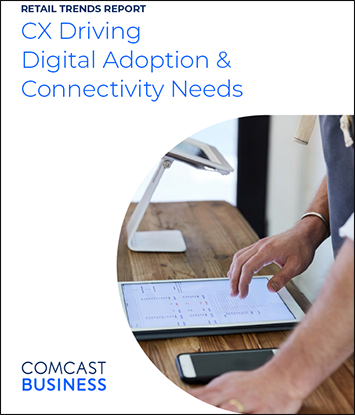Retail Trends Report: CX Driving Digital Adoption & Connectivity Needs

Retail is in the midst of a rapid technology transformation based on the constantly evolving needs of the consumer. Between an increased focus on personalization, digital shopping, and automated purchasing on the consumer side, to a need for digital payment processing, data integration and inventory management on the backend, today’s retail technology must be integrated and agile to keep pace.
Also trending for retails is the demand for frictionless payments, buy online, pick up in-store (BOPIS) options, mobile shopping, and inventory transparency - all of which have become preferred service methods for many consumers.
To prepare for the future, US retailers are partnering up with technology providers that can help streamline and innovate their digital footprint to meet customers’ evolving needs. Based on a survey conducted by DemandScience, in collaboration with Comcast Business, of more than 200 retail IT executives, about half of the respondents said they are prioritizing upgrades to their digital customer experience, expanding the use of analytics-backed decision making, and increasing overall investments in AI.
With IT leaders at the forefront, retailers will continue to seek out solutions that further streamline consumer transactions and gather data insights for improving the company’s backend performance.
Specifically, 43% of retail IT leaders indicate that digital business growth is their most important business priority moving forward, followed by 39% who say that improving the usage of business analytics for decision making is their top priority.
While using customer data to improve the retail experience is nothing new, today’s retailers are focused on capitalizing on the growing availability of data in order to enhance customer engagement. Retailers are primarily using data to digitally engage the customer in-store to drive sales (52%), power rewards programs (51%), and enhance the customer experience (47%).
“The level of granular information retailers can learn about their patrons enables them to hone their operations and services to satisfy customer preferences – down to the individual. And this, in a very real, palpable way, is what digital transformation is all about,” said Jeff Lewis, VP of ActiveCore Products and Solutions, Comcast Business.
One-in-two retail IT executives are working to implement contactless, frictionless transactions within one year. These digital platforms for streamlined transactions include payment methods such as tap-to-pay, buy online and pick up in store, and ordering via app for curbside pickup. But in order for this to happen successfully, retailers may need to implement underlying network technologies such as 5G, WiFi6, and low-power, long-range wide-area networks (LoRaWAN).
Moreover, about 50% of retail IT executives say they are likely to leverage artificial intelligence (AI) for data insights and automation within the same time frame. As with IoT, AI will help sensors get smarter, but they will also need a robust network for optimal performance.
“There will be more needs than any one type of network connectivity will be well-suited to solve,” said Christian Nascimento, Vice President, Product Management, and Strategy, Comcast Business. “The important thing is to find technologies that are complementary and make them work together.”
Digital Transformation Still Has Its Challenges
Taking a deeper look at what new business investments IT decision makers will prioritize in their technology transformations, there is no doubt that IT decision makers are working closer than ever with line-of-business to determine the best ways to improve the consumer experience. As many as 45% of IT decision-makers indicate that inventory availability is an important customer preference that is driving their technology purchase decisions, while another 41% say that personalized shopping experiences are driving their decisions. Plus, 45% of respondents point to the customer preference for free, reliable WiFi as a driver – not to mention its importance to in-store employees.
The Thing About Connectivity
As in any industry, there are obstacles standing in the way of retailers’ success. The recent survey data suggests constraints such as unreliable bandwidth and connectivity, obsolete network infrastructures, and overworked and overburdened assets, are just a few of the hurdles that are holding back IT decision makers from reaching their goals. In other words, the continued migration to digitally-enhanced in-store shopping and online commerce has pushed current connectivity to its limits.
In fact, 34% of IT executives say that constrained bandwidth limits, and overburdened IT systems, along with employee burnout, are holding them back. Additionally, 31% of respondents say that obsolete legacy network infrastructure (including both software and/or hardware) as well as overworked IT teams are some of the most significant obstacles holding them back from digital adoption initiatives.
“Connectivity is the lifeblood of a business these days,” said Nascimento. “Everyone already has broadband or some form of connectivity. It’s not a huge investment to layer sensors and analytics resources on top of that. The longer-term benefits that a business gets far outweigh the costs.”
As the consumer desire for digital ease in purchasing will only continue to grow, retailers will need to be sure their WiFi bandwidth is up for the challenge of supporting a growing tech stack. WiFi is essential for almost every aspect of retail – think in-store monitoring of customer preferences, or finding a product’s location in brick-and-mortar, or tracking product inventory in another location.
Another large hurdle IT leaders report facing is the misalignment between IT team and business strategies. More than one in three (36%) retail IT managers say that misalignment between IT and business strategies is the most significant obstacle holding them back from implementing digital adoption initiatives.
In response to the continued pressure to improve the customer experience that all departments are facing – from sales to service to product development and marketing – IT has an opportunity to take a leadership role and claim its rightful seat at the customer experience/digital transformation strategy table by working side by side with line-of-business stakeholders to define strategies, remove barriers, and help lead successful transformations.
Focus on Solutions
Retailers should consider the advantages that WiFi systems can offer in gathering valuable data about customer shopping interests, traffic patterns and instore engagement. This data can be used for product placement, coupon pushes, reward offers, etc. It can even serve as a map to what aisles and shelves attract more attention and where to place staff for handling customer inquiries.
In addition, Internet of Things (IoT) will continue to play an important role in how retailers connect the dots between inventory availability and operational efficiency — especially with the recent burden of supply chain challenges facing all retailers.
Gaining this level of insight into retail customer preferences requires making an investment in technology and applications. For example, WiFi networks that are open to the public need to be robust and reliable. Retailers need to invest in bandwidth by working with carriers to determine the optimal bandwidth for their specific needs.
Many of today’s retail challenges can be addressed by the agile networking capabilities of SDN/SD-WAN: Faster and easier network management, troubleshooting, and deployment of IT services and greater automation can all help ease the burden on IT systems and employees.Plus, traffic steering and application routing can help address bandwidth constraints, while helping to maintain information security.
With the increased speed to market, and new digital retail models constantly coming into play, the benefits of investing in digital transformation will continue to be a competitive tool for retail enterprises.
Ultimately, improving customer experience increases customer satisfaction, which then drives revenue and growth. But building that experience requires ongoing alignment between business and IT objectives and a sound digital infrastructure.
Comcast Business Delivers Technology to Power Retail
Retailers of all sizes can enable data and analytics transformations and new applications with reliable and secure networking and communications technology, including internet, WiFi and SD-WAN. To learn more visit business.comcast.com/enterprise/industry-solutions/retail.
Consumer preferences are driving technology trends in retail
Locked Content
Click on the button below to get access
Unlock NowOr sign in to access all content on Comcast Business Community
Learn how Comcast Business can help
keep you ready for what's next.











